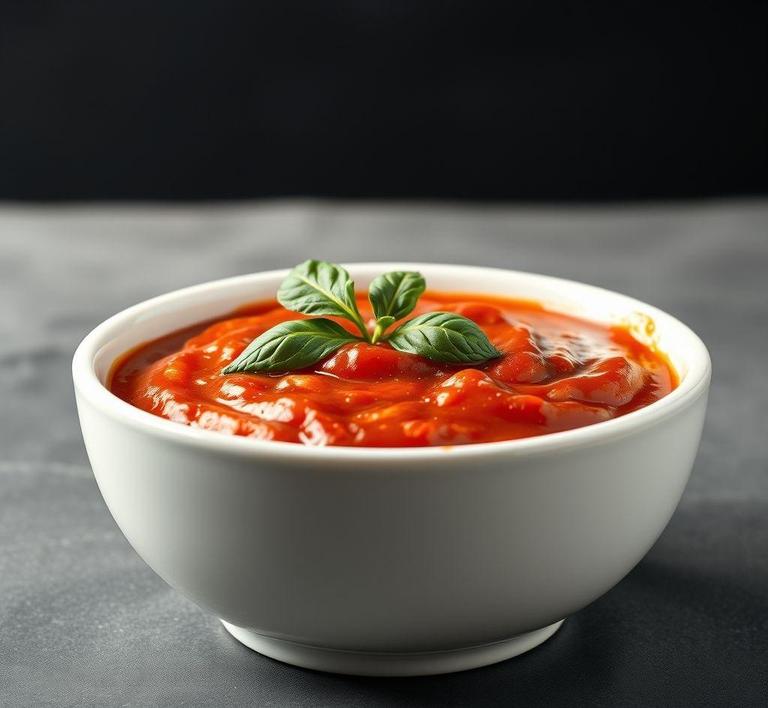Refreezing marinara sauce can be a bit tricky, but with the right tips and tricks, it can definitely be done safely. Whether you’ve made a big batch or have leftovers after a pasta night, understanding how to properly store and refreeze marinara sauce is essential to maintain its flavor and texture. While freezing it initially is a great way to preserve the sauce, refreezing can sometimes cause changes in consistency. In this guide, we’ll walk you through the best methods to safely refreeze marinara sauce, what to watch out for, and how to make sure it tastes just as good the second time around!
Can You Refreeze Marinara Sauce?

Refreezing marinara sauce is a topic that often sparks debate among home cooks and culinary enthusiasts alike. While freezing marinara sauce initially is a great way to extend its shelf life, the question remains: Can you refreeze marinara sauce once it has been thawed?
The simple answer is yes, you can refreeze marinara sauce, but it comes with certain caveats. Just like with many other types of food, the quality and safety of refreezing marinara sauce depend on how it was handled before being frozen again. Marinara sauce, made primarily of tomatoes, olive oil, garlic, herbs, and sometimes vegetables or meat, is relatively resilient, but like any perishable product, it is important to be mindful of a few factors that could affect its taste, texture, and overall safety.
The key to safely refreezing marinara sauce lies in how it is thawed and stored. If the sauce has been thawed in the refrigerator, used in a meal, and then leftover sauce is left at room temperature for an extended period, this introduces the potential for bacteria growth. This bacteria growth would not only affect the quality but also pose food safety risks, which could make you sick if consumed. On the other hand, if the sauce was properly thawed in the refrigerator, not exposed to room temperatures for too long, and not used in a dish (keeping it at the same state as it was before), then it can be refrozen without significant risk.
How To Refreeze Marinara Sauce?
When it comes to refreezing marinara sauce, proper technique and careful attention to food safety practices are paramount. Here’s a detailed guide on how to refreeze marinara sauce while maintaining the best possible quality:
-
Thawing The Sauce
- The safest way to thaw marinara sauce is by moving it from the freezer to the refrigerator. This gradual thawing process minimizes the risk of bacterial growth. You can allow the sauce to thaw for 24 to 48 hours, depending on the quantity.
- Avoid thawing marinara sauce at room temperature or in the microwave unless you plan to use it immediately. These methods can cause uneven heating and promote bacterial growth.
-
Checking The Sauce For Quality
- Before refreezing, inspect the marinara sauce carefully. If there are any signs of spoilage such as an off-smell, mold growth, or an unusual texture (like excessive separation), discard it. These could indicate that the sauce has been exposed to bacteria and should not be refrozen.
-
Portioning The Sauce
- If you plan to refreeze marinara sauce, it’s often a good idea to divide it into smaller portions. This makes it easier to thaw only what you need in the future, reducing the chances of multiple freeze-thaw cycles. You can portion the sauce into small containers or freezer-safe bags, ensuring they are sealed tightly to prevent freezer burn.
-
Freezing
- After portioning, ensure the marinara sauce is stored in an airtight container. Plastic freezer containers, heavy-duty freezer bags, or glass jars (with adequate headspace for expansion) work well for this purpose. Be sure to label the containers with the date so you can keep track of how long it has been in the freezer.
-
Avoiding Freezer Burn
- Freezer burn can damage the texture and taste of the sauce. To minimize this, press out excess air from freezer bags or containers, and store the marinara sauce in the coldest part of your freezer, where temperatures remain consistently below 0°F (-18°C). This will help preserve the sauce’s integrity.
Quality Impact
While refreezing marinara sauce is technically possible, it is important to understand that each subsequent freeze-thaw cycle may impact the sauce’s quality. Several factors play into how the sauce might change, including texture, flavor, and consistency.
-
Texture Changes
- Marinara sauce tends to be somewhat watery because of its tomato base, and freezing causes the water molecules to form ice crystals. These crystals can break down the cell walls of the ingredients, especially the herbs and vegetables, resulting in a more watery, less cohesive texture when the sauce is thawed again. In a single freeze-thaw cycle, the sauce usually retains a good texture, but multiple cycles can cause it to separate and become slightly more runny.
-
Flavor Deterioration
- Freezing marinara sauce may cause slight changes in flavor. Although the sauce will generally retain its basic taste, some subtle nuances can fade with each freezing cycle. Over time, especially if the sauce has been frozen for an extended period, you may notice a reduction in the richness and depth of the flavor. This is because freezing can diminish the potency of the herbs and spices, leading to a less vibrant, more muted taste.
-
Separation
- Some marinara sauces, particularly those with added oils or fats, may separate into different layers when frozen. This can be unsettling to the eye, but it doesn’t necessarily mean the sauce is spoiled. Upon reheating, you can simply stir the sauce to reincorporate the ingredients, although it might never fully return to its original consistency.
-
Nutrient Loss
- Freezing, like any preservation method, can cause some loss of nutrients, particularly the more delicate ones like vitamin C. However, marinara sauce, being primarily tomato-based, still retains a substantial amount of its beneficial nutrients even after freezing. While refreezing can cause a slight degradation in overall nutritional content, it’s unlikely to be significant enough to outweigh the convenience and extended shelf life that freezing provides.
Refreezing marinara sauce is entirely feasible as long as proper food safety protocols are followed. As long as the sauce has been thawed correctly (in the fridge, not at room temperature), and there are no signs of spoilage, you can confidently refreeze it. However, it’s important to be aware of the potential impact on quality. The texture might suffer, flavors may dull, and separation could occur, but the sauce should still be safe to eat and usable in dishes like pasta, pizza, or even as a dipping sauce.
When done correctly, freezing and refreezing marinara sauce can extend its shelf life for months, making it a convenient option for busy home cooks who want to save time without sacrificing too much in terms of flavor or texture. If you plan to do this frequently, it’s recommended to freeze the sauce in smaller portions and avoid multiple refreeze cycles to preserve the best possible outcome. Ultimately, marinara sauce is one of those dishes that still performs well after freezing, even if it may not be quite as fresh as it was when first made.
Is It Safe To Refreeze Marinara Sauce?
The question of whether it’s safe to refreeze marinara sauce is a common one, especially for home cooks looking to reduce food waste or maximize convenience. Refreezing food isn’t always straightforward, and with sauces like marinara, it requires careful attention to preserve both the safety and quality of the dish.
When marinara sauce is initially frozen, the key factors in determining whether it can be safely refrozen involve both how it was initially frozen and how it has been handled afterward. In general, yes, marinara sauce can be refrozen-but there are important caveats to keep in mind.
The most crucial consideration is whether the sauce has been properly thawed and handled during the first thawing process. If the sauce has been stored at a consistent temperature (below 40°F) and hasn’t been sitting out at room temperature for extended periods, then it is typically safe to refreeze. However, if the sauce has been left to thaw at room temperature or for too long (more than two hours), bacteria can begin to grow, which can compromise both safety and flavor. When marinara sauce is refrozen after being improperly thawed, it can become a breeding ground for harmful pathogens, leading to potential foodborne illnesses.
On the flip side, if the marinara sauce was properly cooled, stored, and refrozen within a safe time frame, it’s generally fine. The texture and flavor may change slightly upon thawing and reheating, but the sauce should remain safe to consume.
Signs That Marinara Sauce Should Not Be Refrozen
Knowing when marinara sauce should not be refrozen is crucial to avoiding food safety risks and maintaining the quality of your dish. Here are the most common signs that your marinara sauce has gone bad or should not be refrozen:
- Sour Smell or Off-Taste: A key indicator that marinara sauce is no longer safe to eat or should not be refrozen is a sour or rancid odor. Tomatoes, garlic, and herbs used in marinara sauce can develop off flavors once they’ve been exposed to air, heat, or bacterial growth for too long. If the sauce smells off, it’s best to discard it.
- Mold Growth: If you notice any mold (green, black, or fuzzy white spots) on the surface of the sauce, it’s time to throw it away. Mold can grow on food that has been stored improperly or for too long, and refreezing it won’t eliminate the risk of consuming harmful spores.
- Separation of Liquids: After thawing and reheating marinara sauce, a certain amount of separation between the oil, water, and tomato pulp is normal. However, excessive separation or an oily layer on the surface could indicate the sauce has gone bad. If it’s particularly watery or if the texture seems off, it may no longer be safe to refreeze.
- Changes in Color or Appearance: If the sauce has significantly darkened or looks discolored after freezing or thawing, it may be a sign that the ingredients have deteriorated. A dull, unappetizing appearance, along with texture changes, could indicate that the sauce has been subjected to temperature fluctuations, making it unsuitable for further freezing.
- Inconsistent Freezing/Thawing: If the sauce has been frozen and thawed multiple times before, you may notice the texture breaking down or the sauce becoming very watery. This could be a result of freezing and thawing causing the ingredients to lose moisture or separate in undesirable ways. While still safe in many cases, it might not be worth refreezing again due to poor texture and flavor.
Common Refreezing Mistakes
Refreezing marinara sauce-or any food, for that matter-requires attention to detail. Here are some of the most common mistakes people make when attempting to refreeze their sauce and how to avoid them:
- Thawing at Room Temperature: The biggest mistake is allowing marinara sauce to thaw at room temperature, which is a breeding ground for bacteria. It’s important to always thaw frozen marinara sauce in the fridge or using a microwave, especially if you plan to refreeze it. The slow, steady thawing process ensures the sauce remains at a safe temperature, preventing bacterial growth.
- Refreezing Without Proper Cooling: If you’re not sure whether your marinara sauce has been cooled properly before being stored in the freezer, it’s better to err on the side of caution. Sauces should be cooled quickly to room temperature and transferred to airtight containers or freezer bags to avoid the risk of bacterial growth. Never refreeze marinara sauce that has been sitting out for more than a few hours or has not been stored in a timely manner.
- Freezing Sauce in Large Batches: Freezing marinara sauce in large batches can be a mistake if you plan to thaw and refreeze it multiple times. The larger the batch, the slower it will freeze and thaw. Instead, freeze smaller portions in containers or resealable bags that can be easily thawed and consumed without having to refreeze large quantities.
- Not Using Proper Freezer Storage: Freezing marinara sauce without ensuring airtight storage is a major mistake. Exposure to air can lead to freezer burn, which makes the sauce dry, flavorless, and less appealing. Always use airtight containers or vacuum-sealed bags to ensure the sauce stays fresh and protected from freezer burn.
- Not Allowing the Sauce to Cool Completely Before Freezing: Another mistake many people make is placing warm marinara sauce directly into the freezer. The rapid temperature change can affect the sauce’s consistency and may cause ice crystals to form, negatively affecting texture. Let the sauce cool to room temperature first, and then freeze it.
Tips And Tricks
To make the process of freezing and refreezing marinara sauce easier and to preserve the quality and safety of your sauce, here are some valuable tips:
- Freeze in Portions: Divide your marinara sauce into smaller portions before freezing. This allows you to thaw only what you need, avoiding the need to refreeze an entire batch. Use ice cube trays for small portions or resealable bags for larger servings.
- Label Your Containers: Always label your marinara sauce containers with the date you froze them. This will help you keep track of how long the sauce has been in the freezer, so you know whether it’s safe to refreeze. Typically, frozen marinara sauce lasts up to three months, but the sooner you use it, the better.
- Add Fresh Ingredients After Freezing: If you want to maintain the best flavor and texture, consider adding fresh herbs, a bit of fresh garlic, or a sprinkle of Parmesan cheese to your marinara sauce after it has been thawed and reheated. This can help restore some of the fresh flavors lost during freezing and refreezing.
- Avoid Overcooking Before Freezing: Before freezing your marinara sauce, avoid overcooking it. The longer you cook the sauce, the more it reduces and the stronger its flavors become. Overcooking can lead to a more intense, sometimes overly bitter, flavor after refreezing. Keep the sauce at a medium simmer for optimal taste and texture.
- Freeze It Quickly: Once the marinara sauce has been cooled, make sure to freeze it quickly. The faster it freezes, the fewer ice crystals will form, which helps maintain the sauce’s texture when thawed. To achieve this, use shallow containers or bags to freeze the sauce in smaller amounts.
Conclusion
In conclusion, while it is safe to refreeze marinara sauce under the right conditions, it’s essential to be mindful of how you handle and store the sauce. Refreezing isn’t always ideal due to potential changes in texture and flavor, but it can be done safely as long as the sauce is properly thawed, handled, and stored. Paying close attention to the signs that your marinara sauce has gone bad, avoiding common refreezing mistakes, and employing helpful tips like portioning and labeling can ensure that your marinara sauce remains both safe to eat and delicious. So, whether you’re looking to minimize waste or simply want to make your marinara sauce last longer, these guidelines will help you refreeze with confidence.


